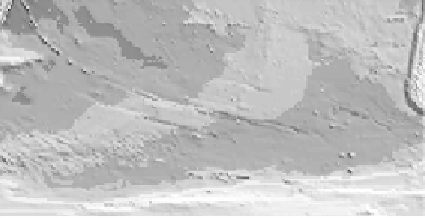Geology Reference
In-Depth Information
Figure 8.2. Topography of the sea floor near the Eltanin fracture zone in the
southeast Pacific (compare with the global map, Figure 2.4). The East Pacific
Rise is cleanly offset by the Eltanin transform fault, with no indication of rise
topography extending across the fault. This is explained if the rise topography is
due entirely to near-surface cooling with no contribution from a putative buoyant
upwelling under the rise.
source of buoyancy under ridges is a hangover from simple textbook examples of
convection (such as Figure 6.2), which are driven equally by hot and cold thermal
boundary layers acting in a coordinated way. We noted in Chapter 3 that the idea
actually impeded the understanding of plate tectonics. The point being made here
does not apply to mid-ocean ridge segments that have a mantle plume rising under
them, such as Iceland, but those are clearly the exception.
Not only is there no need to invoke buoyant upwellings under mid-ocean ridges,
but also there is clear evidence against such upwellings. If such active upwellings
existed, they would contribute to seafloor topography by lifting ridges even higher
than they are. Subsidence of sea floor as it aged would then be due to two causes:
thermal contraction, as we discussed in Chapter 6, and moving off the active
upwelling. The result would be that sea floor would for a time subside faster than
predicted by the square root of age cooling. This would destroy the correlation
between seafloor depth and the square root of age shown in Figure 2.5.
The absence of active upwellings is manifest in another way. If there were buoy-
ant upwellings under ridges, the upwellings would have to be offset at transform
faults. The fluid upwelling would cause a more continuous uplift than the sharp,
faulted offsets of the brittle lithosphere. We would therefore expect some uplift
to extend beyond the end of each ridge segment and some uplift of the transform
faults connecting spreading centre segments.
Figure 8.2 shows topography of the sea floor near one of the longest transform
offsets of any spreading centre, at the Eltanin fracture zone in the southeast Pacific.
It is striking how cleanly the whole mid-ocean ridge structure is terminated and
offset by the transform fault. Where the spreading centre is terminated by the
transform fault, the sea floor on the other side is at a depth normal for its age. There

